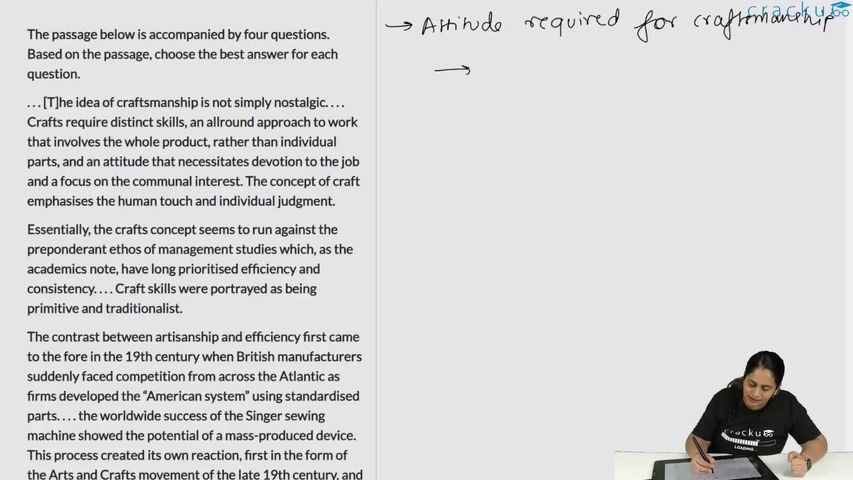The passage below is accompanied by four questions. Based on the passage, choose the best answer for each question.
. . . [T]he idea of craftsmanship is not simply nostalgic. . . . Crafts require distinct skills, an allround approach to work that involves the whole product, rather than individual parts, and an attitude that necessitates devotion to the job and a focus on the communal interest. The concept of craft emphasises the human touch and individual judgment.
Essentially, the crafts concept seems to run against the preponderant ethos of management studies which, as the academics note, have long prioritised efficiency and consistency. . . . Craft skills were portrayed as being primitive and traditionalist.
The contrast between artisanship and efficiency first came to the fore in the 19th century when British manufacturers suddenly faced competition from across the Atlantic as firms developed the “American system” using standardised parts. . . . the worldwide success of the Singer sewing machine showed the potential of a mass-produced device. This process created its own reaction, first in the form of the Arts and Crafts movement of the late 19th century, and then again in the “small is beautiful” movement of the 1970s. A third crafts movement is emerging as people become aware of the environmental impact of conventional industry.
There are two potential markets for those who practise crafts. The first stems from the existence of consumers who are willing to pay a premium price for goods that are deemed to be of extra quality. . . . The second market lies in those consumers who wish to use their purchases to support local workers, or to reduce their environmental impact by taking goods to craftspeople to be mended, or recycled.
For workers, the appeal of craftsmanship is that it allows them the autonomy to make creative choices, and thus makes a job far more satisfying. In that sense, it could offer hope for the overall labour market. Let the machines automate dull and repetitive tasks and let workers focus purely on their skills, judgment and imagination. As a current example, the academics cite the “agile” manifesto in the software sector, an industry at the heart of technological change. The pioneers behind the original agile manifesto promised to prioritise “individuals and interactions over processes and tools”. By bringing together experts from different teams, agile working is designed to improve creativity.
But the broader question is whether crafts can create a lot more jobs than they do today. Demand for crafted products may rise but will it be easy to retrain workers in sectors that might get automated (such as truck drivers) to take advantage? In a world where products and services often have to pass through regulatory hoops, large companies will usually have the advantage.
History also suggests that the link between crafts and creativity is not automatic. Medieval craft guilds were monopolies which resisted new entrants. They were also highly hierarchical with young men required to spend long periods as apprentices and journeymen before they could set up on their own; by that time the innovative spirit may have been knocked out of them. Craft workers can thrive in the modern era, but only if they don’t get too organised.
The author questions the ability of crafts to create substantial employment opportunities presently because
Option B is the correct answer.
The author says "In a world where products and services often have to pass through regulatory hoops, large companies will usually have the advantage." From this, we can infer that the author doubts whether crafts can create substantial employment opportunities because smaller craft businesses may struggle to compete with larger companies due to regulatory barriers.
Option A: The passage does not focus on the low scale of crafts production as the primary obstacle. Instead, the author emphasizes regulatory challenges and not the scale.
Option C: The passage does not argue that workers wouldn’t want to pursue crafts-related work, just that retraining them for these roles might be difficult.
Option D: The passage mentions that craft guilds resisted new entrants, but it does not suggest that they are unlikely to accept large number of trainees. The passage suggests that craft workers can thrive in the modern era, but the challenge lies in how modern crafts are organized and their potential to scale up in a competitive market.
Video Solution

Create a FREE account and get:
- All Quant CAT complete Formulas and shortcuts PDF
- 38+ CAT previous year papers with video solutions PDF
- 5000+ Topic-wise Previous year CAT Solved Questions for Free



